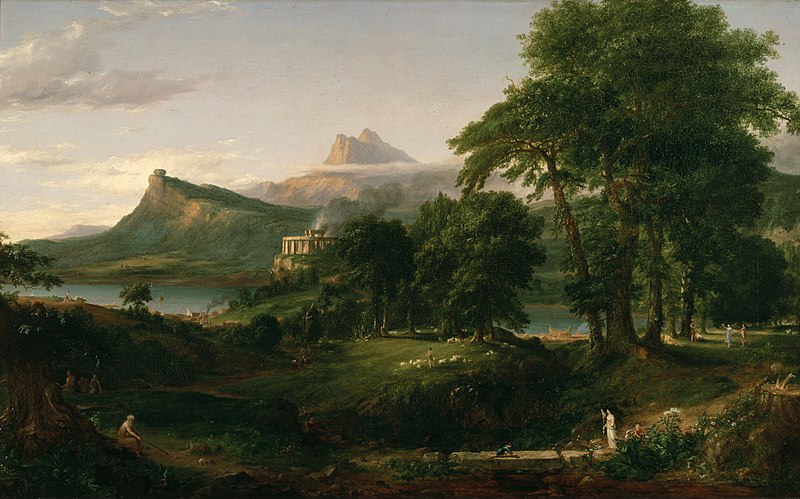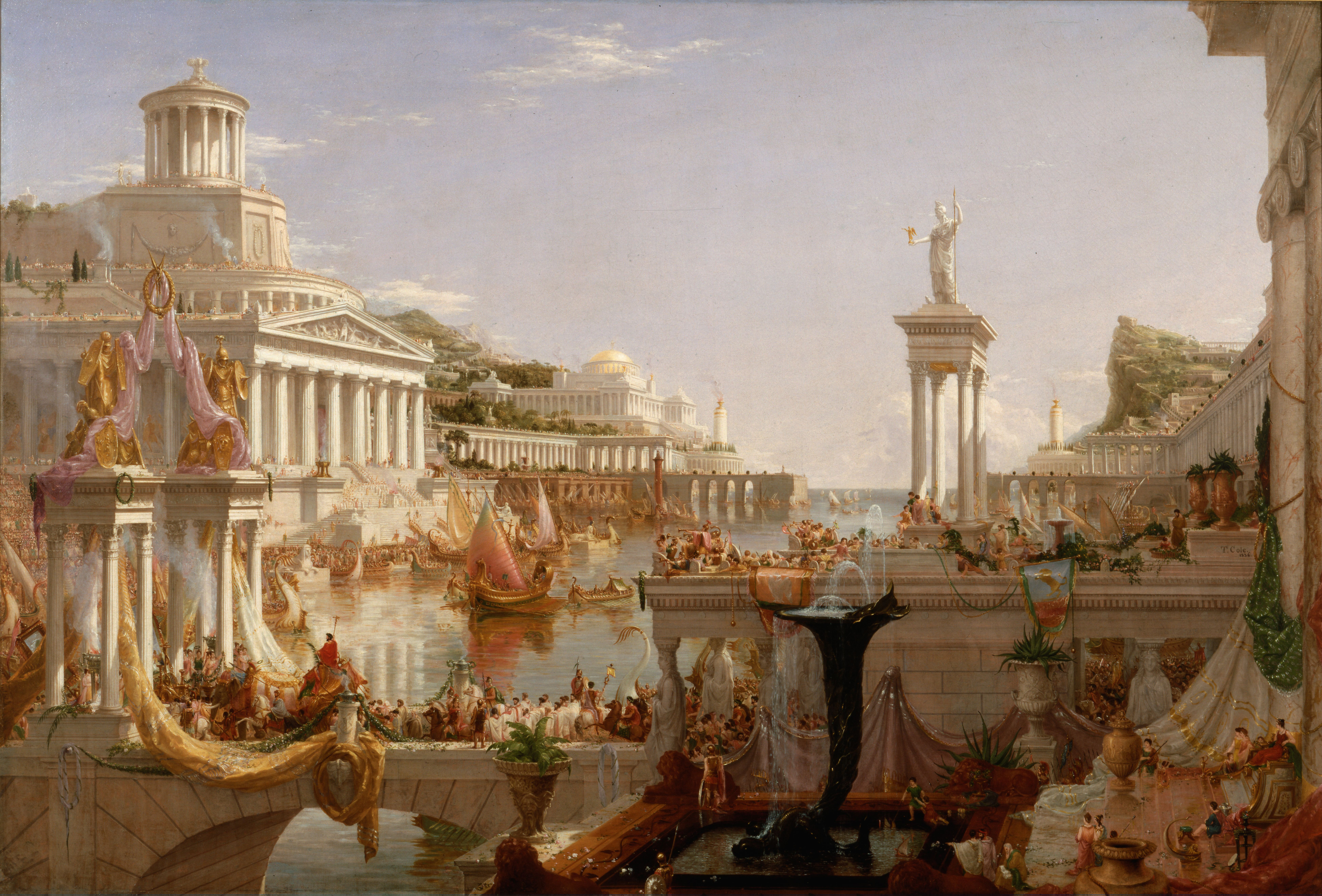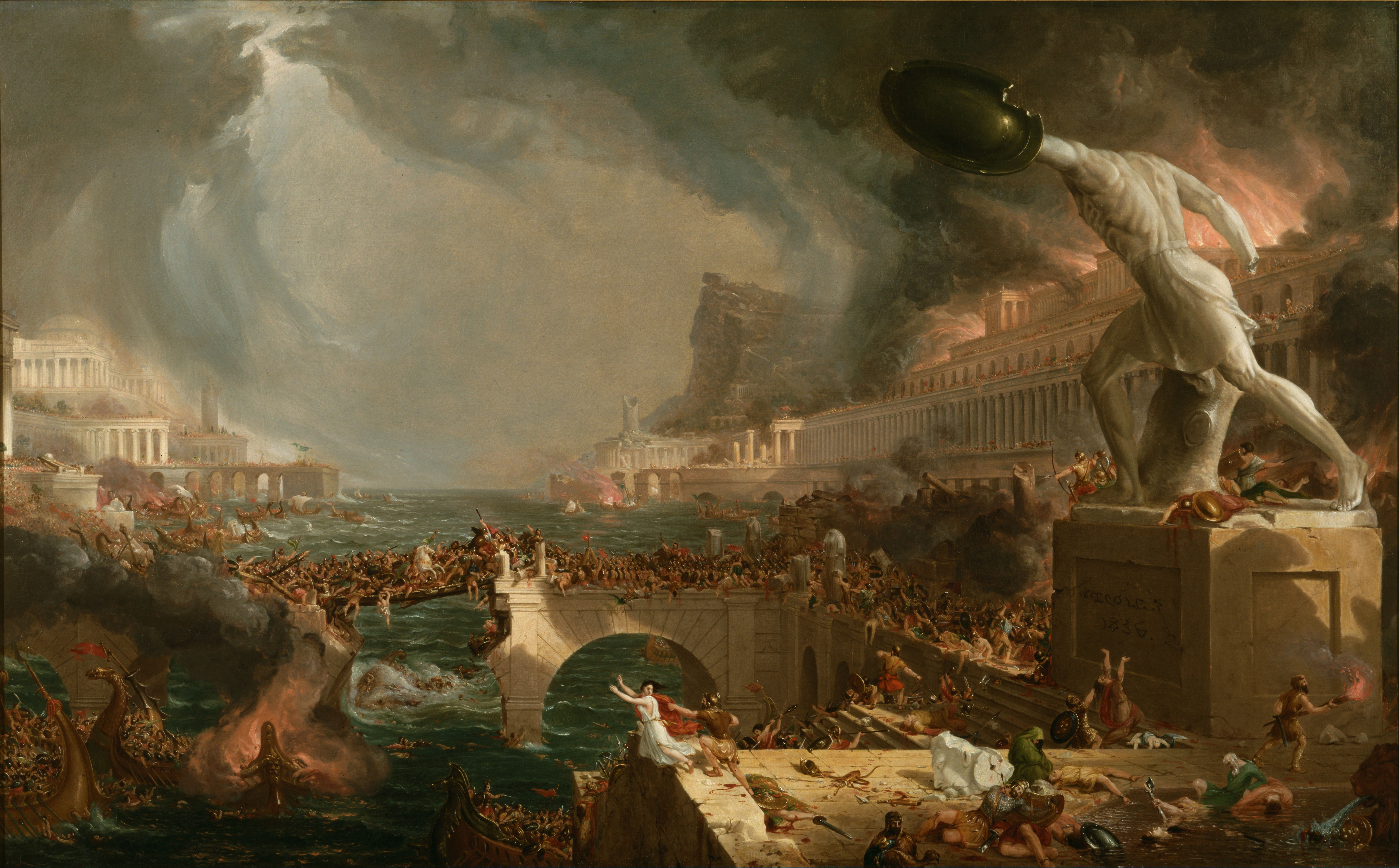Course of Empire, Thomas Cole
In the 1830s, painter Thomas Cole painted a series titled Course of Empire which chronicled the decline of the Roman Empire. This series of paintings is similar to a kind of saeculum and its course of turnings.
See Robert Hughes' piece on the Course of Empire here.
The paintings do not directly correlate with the sequence of turnings, and all five of them overlap to a large degree. The first and fifth paintings actually create a loop point, such that the "destruction" state cycles directly back to a pristine "savage" state of renewal.

The first painting, The Savage State, shows the valley from the shore opposite the crag, in the dim light of a dawning stormy day. A hunter clad in skins hastens through the wilderness, pursuing a deer; canoes paddle up the river; on the far shore can be seen a clearing with a cluster of wigwams around a fire, the nucleus of the city that is to be. The visual references are those of Native American life.

In the second painting, The Arcadian or Pastoral State, the sky has cleared and we are in the fresh morning of a day in spring or early summer. The viewpoint has shifted further down the river, as the crag with the boulder is now on the left-hand side of the painting; a forked peak can be seen in the distance beyond it. Much of the wilderness has given way to settled lands, with plowed fields and lawns visible. Various activities go on in the background: plowing, boat-building, herding sheep, dancing; in the foreground, an old man sketches what may be a geometrical problem with a stick. On a bluff on the near side of the river, a megalithic temple has been built, and smoke (presumably from sacrifices) arises from it. The images reflect an idealized, pre-urban ancient Greece.

The third painting, The Consummation of Empire, shifts the viewpoint to the opposite shore, approximately the site of the clearing in the first painting. It is noontide of a glorious summer day. Both sides of the river valley are now covered in colonnaded marble structures, whose steps run down into the water. The megalithic temple seems to have been transformed into a huge domed structure dominating the river-bank. The mouth of the river is guarded by two pharoses, and ships with lateen sails go out to the sea beyond. A joyous crowd throngs the balconies and terraces as a scarlet-robed king or victorious general crosses a bridge connecting the two sides of the river in a triumphal procession. In the foreground an elaborate fountain gushes. The overall look suggests the height of ancient Rome.

The fourth painting, Destruction, has almost the same perspective as the third, though the artist has stepped back a bit to allow a wider scene of the action, and moved almost to the center of the river. The action is the sack and destruction of the city, in the course of a tempest seen in the distance. It seems that a fleet of enemy warriors has overthrown the city's defenses, sailed up the river, and is busily firing the city and killing and raping its inhabitants. The bridge across which the triumphal procession had crossed is broken; a makeshift crossing strains under the weight of soldiers and refugees. Columns are broken, fire breaks from the upper floors of a palace on the river bank. In the foreground a statue of some venerable hero (posed like the Borghese Warrior) stands headless, still striding forward into the uncertain future, reminiscent of the hunter in the first painting. The scene is perhaps suggested by the Vandal sack of Rome in 455.

The fifth painting, Desolation, shows the results, years later. We view the remains of the city in the livid light of a dying day. The landscape has begun to return to wilderness, and no human beings are to be seen; but the remnants of their architecture emerge from beneath a mantle of trees, ivy, and other overgrowth. The broken stumps of the pharoses loom in the background. The arches of the shattered bridge, and the columns of the temple are still visible; a single column looms in the foreground, now a nesting place for birds. The sunrise of the first painting is mirrored here by a moonrise, a pale light reflecting in the ruin-choked river while the standing pillar reflects the last rays of sunset.
See Robert Hughes' piece on the Course of Empire here.
The paintings do not directly correlate with the sequence of turnings, and all five of them overlap to a large degree. The first and fifth paintings actually create a loop point, such that the "destruction" state cycles directly back to a pristine "savage" state of renewal.
The Savage State (First Turning, 1946-1963)

The first painting, The Savage State, shows the valley from the shore opposite the crag, in the dim light of a dawning stormy day. A hunter clad in skins hastens through the wilderness, pursuing a deer; canoes paddle up the river; on the far shore can be seen a clearing with a cluster of wigwams around a fire, the nucleus of the city that is to be. The visual references are those of Native American life.
The Arcadian or Pastoral State (First Turning, continued)

In the second painting, The Arcadian or Pastoral State, the sky has cleared and we are in the fresh morning of a day in spring or early summer. The viewpoint has shifted further down the river, as the crag with the boulder is now on the left-hand side of the painting; a forked peak can be seen in the distance beyond it. Much of the wilderness has given way to settled lands, with plowed fields and lawns visible. Various activities go on in the background: plowing, boat-building, herding sheep, dancing; in the foreground, an old man sketches what may be a geometrical problem with a stick. On a bluff on the near side of the river, a megalithic temple has been built, and smoke (presumably from sacrifices) arises from it. The images reflect an idealized, pre-urban ancient Greece.
The Consummation of Empire (Second and Third Turnings, 1964-1983/1984-2001)

The third painting, The Consummation of Empire, shifts the viewpoint to the opposite shore, approximately the site of the clearing in the first painting. It is noontide of a glorious summer day. Both sides of the river valley are now covered in colonnaded marble structures, whose steps run down into the water. The megalithic temple seems to have been transformed into a huge domed structure dominating the river-bank. The mouth of the river is guarded by two pharoses, and ships with lateen sails go out to the sea beyond. A joyous crowd throngs the balconies and terraces as a scarlet-robed king or victorious general crosses a bridge connecting the two sides of the river in a triumphal procession. In the foreground an elaborate fountain gushes. The overall look suggests the height of ancient Rome.
Destruction (Third and Fourth Turnings, 1985-2001/2001-2025)

The fourth painting, Destruction, has almost the same perspective as the third, though the artist has stepped back a bit to allow a wider scene of the action, and moved almost to the center of the river. The action is the sack and destruction of the city, in the course of a tempest seen in the distance. It seems that a fleet of enemy warriors has overthrown the city's defenses, sailed up the river, and is busily firing the city and killing and raping its inhabitants. The bridge across which the triumphal procession had crossed is broken; a makeshift crossing strains under the weight of soldiers and refugees. Columns are broken, fire breaks from the upper floors of a palace on the river bank. In the foreground a statue of some venerable hero (posed like the Borghese Warrior) stands headless, still striding forward into the uncertain future, reminiscent of the hunter in the first painting. The scene is perhaps suggested by the Vandal sack of Rome in 455.
Desolation (Fin Du Monde) (Fourth and First Turnings, 2001-2025, 2026-2046)

The fifth painting, Desolation, shows the results, years later. We view the remains of the city in the livid light of a dying day. The landscape has begun to return to wilderness, and no human beings are to be seen; but the remnants of their architecture emerge from beneath a mantle of trees, ivy, and other overgrowth. The broken stumps of the pharoses loom in the background. The arches of the shattered bridge, and the columns of the temple are still visible; a single column looms in the foreground, now a nesting place for birds. The sunrise of the first painting is mirrored here by a moonrise, a pale light reflecting in the ruin-choked river while the standing pillar reflects the last rays of sunset.

Comments
Post a Comment